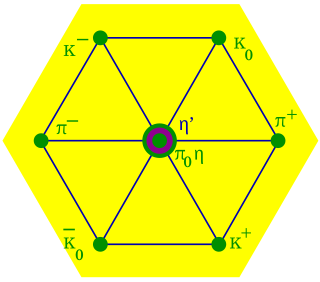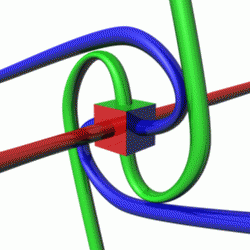Original device
Assumptions

In Mermin's original thought experiment, he considers a device consisting of three parts: two detectors A and B, and a source C. [4] The source emits two particles whenever a button is pushed, one particle reaches detector A and the other reaches detector B. The three parts A, B and C are isolated from each other (no connecting pipes, no wires, no antennas) in such a way that the detectors are not signaled when the button of the source has been pushed nor when the other detector has received a particle.
Each detector (A and B) has a switch with three configurations labeled (1,2 and 3) and a red and a green light bulb. Either the green or the red light will turn on (never both) when a particle enters the device after a given period of time. The light bulbs only emit light in the direction of the observer working on the device.
Additional barriers or instrument can be put in place to check that there is no interference between the three parts (A,B,C), as the parts should remain as independent as possible. Only allowing for a single particle to go from C to A and a single particle from C to B, and nothing else between A and B (no vibrations, no electromagnetic radiation).
The experiment runs in the following way. The button of the source C is pushed, particles take some time to travel to the detectors and the detectors flash a light with a color determined by the switch configuration. There are nine total possible configuration of the switches (three for A, three for B).
The switches can be changed at any moment during the experiment, even if the particles are still traveling to reach the detectors, but not after the detectors flash a light. The distance between the detectors can be changed so that the detectors flash a light at the same time or at different times. If detector A is set to flash a light first, the configuration of the switch of detector B can be changed after A has already flashed (similarly if B set to flash first, the settings of A can be change before A flashes).
Results
The results of the experiment are given in this table in percentages: [4]
| Setting of detector 1 | Setting of detector 2 | Flash the same colors (%) | Flash opposite colors (%) |
|---|---|---|---|
| 1 | 1 | 100 | 0 |
| 2 | 2 | ||
| 3 | 3 | ||
| 1 | 2 | 25 | 75 |
| 1 | 3 | ||
| 2 | 1 | ||
| 2 | 3 | ||
| 3 | 1 | ||
| 3 | 2 |
Every time the detectors are set to the same setting, the bulbs in each detector always flash same colors (either A and B flash red, or A and B flash green) and never opposite colors (A red B green, or A green B red). Every time the detectors are at different setting, the detectors flash the same color a quarter of the time and opposite colors 3/4 of the time. The challenge consists in finding a device that can reproduce these statistics.
Hidden variables and classical mechanics
In order to make sense of the data using classical mechanics, one can consider the existence of three variables per particle that are measured by the detectors and follow the percentages above. [4] Particle that goes into detector A has variables and the particle that goes into detector B has variables . These variables determine which color will flash for a specific setting (1,2 and 3). For example, if the particle that goes in A has variables (R,G,G), then if the detector A is set to 1 it will flash red (labelled R), set to 2 or 3 it will flash green (labelled G).
We have 8 possible states:
| (G,G,G) | (G,G,G) |
| (G,G,R) | (G,G,R) |
| (G,R,G) | (G,R,G) |
| (G,R,R) | (G,R,R) |
| (R,G,G) | (R,G,G) |
| (R,G,R) | (R,G,R) |
| (R,R,G) | (R,R,G) |
| (R,R,R) | (R,R,R) |
where in order to reproduce the results of table 1 when selecting the same setting for both detectors.
For any given configuration, if the detector settings were chosen randomly, when the settings of the devices are different (12,13,21,23,31,32), the color of their lights would agree 100% of the time for the states (GGG) and (RRR) and for the other states the results would agree 1/3 of the time.
Thus we reach an impossibility: there is no possible distribution of these states that would allow for the system to flash the same colors 1/4 of the time when the settings are not the same. Thereby, it is not possible to reproduce the results provided in Table 1.
Quantum mechanics


Table 1 can be reproduced using quantum mechanics using quantum entanglement. [4] Mermin reveals a possible construction of his device based on David Bohm's version of the Einstein–Podolsky–Rosen paradox.
One can set two spin-1/2 particles in the maximally entangled singlet Bell state:
- ,
to leave the experiment, where () is the state where the projection of the spin of particle 1 is aligned (anti-aligned) with a given axis and particle 2 is anti-aligned (aligned) to the same axis. The measurement devices can be replaced with Stern–Gerlach devices, that measure the spin in a given direction. The three different settings determine whether the detectors are vertical or at ±120° to the vertical in the plane of perpendicular to the line of flight of the particles. Detector A flashes green when the spin of the measured particle is aligned with the detector's magnetic field and flashes red when anti-aligned. Detector B has the opposite color scheme with respect to A. Detector B flashes red when the spin of the measured particle is aligned and flashes green when anti-aligned. Another possibility is to use photons that have two possible polarizations, using polarizers as detectors, as in Aspect's experiment.
Quantum mechanics predicts a probability of measuring opposite spin projections given by
where is the relative angle between settings of the detectors. For and the system reproduces the result of table 1 keeping all the assumptions.





















